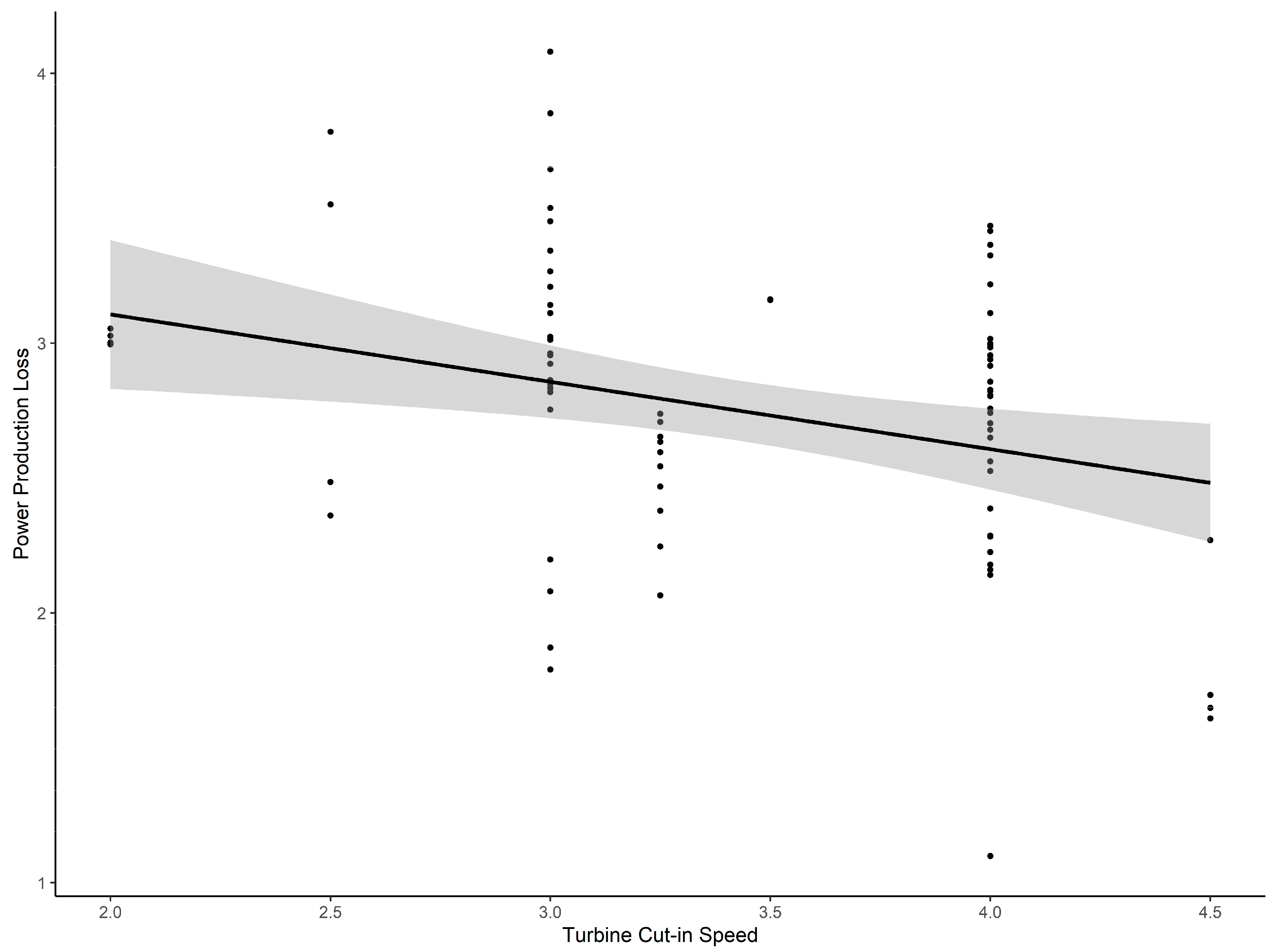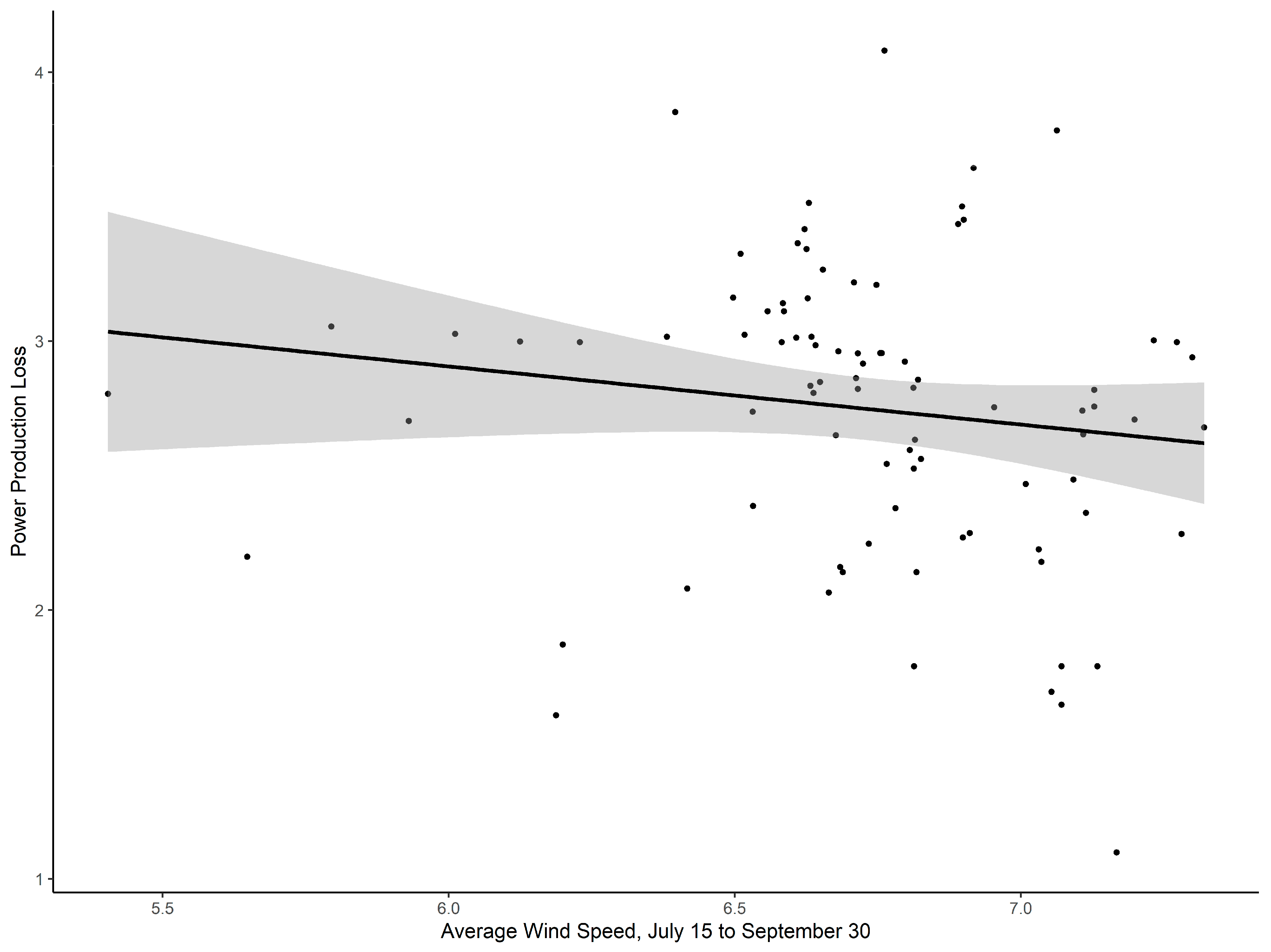Economic Impacts of Curtailing Wind Turbine Operations for the Protection of Bat Populations in Ontario
Abstract
1. Introduction
2. Materials and Methods
3. Results
4. Discussion
5. Limitations
6. Conclusions and Suggestion for Future Studies
Supplementary Materials
Author Contributions
Funding
Institutional Review Board Statement
Informed Consent Statement
Data Availability Statement
Acknowledgments
Conflicts of Interest
References
- Natural Resources Canada. About Renewable Energy. 2017. Available online: https://www.nrcan.gc.ca/our-natural-resources/energy-sources-distribution/renewable-energy/about-renewable-energy/7295 (accessed on 1 December 2022).
- Canada Energy Regulator. Canada’s Energy Future: Key Findings. 2022. Available online: https://www.cer-rec.gc.ca/en/data-analysis/canada-energy-future/2021/key-findings.html (accessed on 1 December 2022).
- International Renewable Energy Agency. Renewable Capacity Statistics 2021; International Renewable Energy Agency: Abu Dhabi, United Arab Emirates, 2021. [Google Scholar]
- Canadian Renewable Energy Association. By the Numbers. Available online: https://renewablesassociation.ca/by-the-numbers/ (accessed on 1 June 2023).
- Statistics Canada. Electric Power Generation, Monthly Generation by Type of Electricity. 2022. Available online: https://www150.statcan.gc.ca/t1/tbl1/en/tv.action?pid=2510001501&pickMembers%5B0%5D=1.1&pickMembers%5B1%5D=2.1&cubeTimeFrame.startMonth=01&cubeTimeFrame.startYear=2021&cubeTimeFrame.endMonth=12&cubeTimeFrame.endYear=2021&referencePeriods=20210101%2C20211 (accessed on 14 December 2022).
- Cryan, P.M. Wind turbines as landscape impediments to the migratory connectivity of bats. Environ. Law 2011, 41, 355–370. [Google Scholar]
- O’Shea, T.J.; Cryan, P.M.; Hayman, D.T.S.; Plowright, R.K.; Streicker, D.G. Multiple mortality events in bats: A global review. Mammal Rev. 2016, 46, 175–190. [Google Scholar] [CrossRef] [PubMed]
- Arnett, E.B.; Baerwald, E.F. Impacts of wind energy development on bats: Implications for conservation. In Bat Evolution, Ecology, and Conservation; Adams, R.A., Peterson, S.C., Eds.; Springer Science Press: New York, NY, USA, 2013. [Google Scholar]
- Hayes, M.A. Bats killed in large numbers at United States wind energy facilities. BioScience 2013, 63, 975–979. [Google Scholar]
- Zimmerling, J.R.; Francis, C.M. Bat mortality due to wind turbines in Canada. J. Wildl. Manag. 2016, 80, 1360–1369. [Google Scholar] [CrossRef]
- Frick, W.F.; Baerwald, E.F.; Pollock, J.F.; Barclay, R.M.; Szymanski, J.A.; Weller, T.J.; Russell, A.L.; Loeb, S.C.; Medellin, R.A.; McGuire, L.P. Fatalities at wind turbines may threaten population viability of a migratory bat. Biol. Conserv. 2017, 209, 172–177. [Google Scholar] [CrossRef]
- Hammerson, G.A.; Kling, K.; Harkness, M.; Ormes, M.; Young, B.E. Strong geographic and temporal patterns in conservation status of North American bats. Biol. Conserv. 2017, 212, 144–152. [Google Scholar] [CrossRef]
- Davy, C.M.; Squires, K.; Zimmerling, J.R. Estimation of spatiotemporal trends in bats abundance from mortality data collected at wind turbines. Conserv. Biol. 2020, 35, 227–238. [Google Scholar] [CrossRef]
- Friedenberg, N.A.; Frick, W.F. Assessing fatality minimization for hoary bats amid continued wind energy development. Biol. Conserv. 2021, 262, 109309. [Google Scholar] [CrossRef]
- Committee on the Status of Endangered Wildlife in Canada. Seeing Conservation Solutions for Unseen Species. Available online: https://www.cosewic.ca/index.php/en-ca/news-and-events/press-release-may-2023.html (accessed on 1 June 2023).
- Johnson, G.D. A review of bat mortality at wind-energy developments in the United States. Bat Res. News 2005, 46, 45–49. [Google Scholar]
- Arnett, E.B.; Brown, K.; Erickson, W.P.; Fiedler, J.K.; Hamilton, B.L.; Henry, T.L.; Jain, A.; Johnson, G.D.; Kerns, J.; Koford, R.R.; et al. Patterns of fatality of bats at wind energy facilities in North America. J. Wildl. Manag. 2008, 72, 61–78. [Google Scholar] [CrossRef]
- Environment and Climate Change Canada. Recovery Strategy for the Little Brown Myotis (Myotis lucifugus), the Northern Myotis (Myotis septentrionalis), and the Tri-Colored Bat (Perimyotis subflavus) in Canada; Species at Risk Act Recovery Strategy Series; Environment and Climate Change Canada: Ottawa, ON, Canada, 2018.
- Arnett, E.B.; Johnson, G.D.; Erickson, W.P.; Hein, C.D. A Synthesis of Operational Mitigation Studies to Reduce Bat Fatalities at Wind Energy Facilities in North America; National Renewable Energy Laboratory: Golden, CO, USA, 2013.
- Ontario Ministry of Natural Resources [OMNR]. Bat and Bat Habitat Guidelines: Guidelines for Wind Power Projects, 2nd ed.; Ontario Ministry of Natural Resources and Forestry: Peterborough, ON, Canada, 2011.
- Baerwald, E.F.; Edworthy, J.; Holder, M.; Barclay, R.M.R. A large-scale mitigation experiment to reduce bat fatalities at wind energy facilities. J. Wildl. Manag. 2009, 73, 1077–1081. [Google Scholar] [CrossRef]
- Arnett, E.B.; Huso, M.M.P.; Schirmacher, M.R.; Hayes, J.P. Altering turbine speed reduces bat mortality at wind-energy facilities. Front. Ecol. Environ. 2011, 9, 209–214. [Google Scholar] [CrossRef]
- Arnett, E.B.; May, R.F. Mitigating wind energy impacts on wildlife: Approaches for multiple taxa. Hum.-Wildl. Interact. 2016, 10, 28–41. [Google Scholar]
- Martin, C.M.; Arnett, E.B.; Stevens, R.D.; Wallace, M.C. Reducing bat fatalities at wind facilities while improving the economic efficiency of operational mitigation. J. Mammal. 2017, 98, 378–385. [Google Scholar] [CrossRef]
- Adams, E.M.; Gulka, J.; Williams, K.A. A review of the effectiveness of operational curtailment for reducing bat fatalities at terrestrial wind farms in North America. PLoS ONE 2021, 16, e0256382. [Google Scholar] [CrossRef] [PubMed]
- Arnett, E.B.; Hein, C.D.; Schirmacher, M.R.; Huso, M.M.P.; Szewczak, J.M. Evaluating the effectiveness of an ultrasonic acoustic deterrent for reducing bat fatalities at wind turbines. PLoS ONE 2013, 8, e65794. [Google Scholar] [CrossRef]
- Squires, K.A.; Thurber, B.G.; Zimmerling, J.R.; Francis, C.M. Timing and weather offer alternative mitigation strategies for lowering bat mortality at wind energy facilities in Ontario. Animals 2021, 11, 3503. [Google Scholar] [CrossRef]
- Rnjak, D.; Janeš, M.; Križan, J.; Antonić, O. Reducing bat mortality at wind farms using site-specific mitigation measures: A case study in the Mediterranean region, Croatia. Mammalia 2022, 10, 1515. [Google Scholar] [CrossRef]
- Hayes, M.A.; Hooton, L.A.; Gilland, K.L.; Grandgent, C.; Smith, R.L.; Lindsay, S.R.; Collins, J.D.; Schumacher, S.M.; Rabie, P.A.; Gruver, J.C.; et al. A smart curtailment approach for reducing bat fatalities and curtailment time at wind energy facilities. Ecol. Appl. 2019, 29, e01881. [Google Scholar] [CrossRef]
- Natural Resources Canada. Canadian Wind Turbine Database. 2021. Available online: https://open.canada.ca/data/en/dataset/79fdad93-9025-49ad-ba16-c26d718cc070 (accessed on 1 December 2022).
- Environment and Climate Change Canada. Modelled Historical Data. 2016. Available online: http://www.windatlas.ca/series/index-en.php (accessed on 1 December 2022).
- Clifton, A.; Smith, A.; Fields, M. Wind Plant Preconstruction Energy Estimates: Current Practice and Opportunities; National Renewable Energy Laboratory: Golden, CO, USA, 2016.
- Independent Electricity System Operator [IESO]. Year-End Data 2021. 2023. Available online: https://www.ieso.ca/en/Corporate-IESO/Media/Year-End-Data/2021 (accessed on 19 June 2023).
- IESO. Feed-in Tariff Program. 2020. Available online: https://www.ieso.ca/en/Power-Data/Data-Directory (accessed on 1 December 2022).
- Rogers, A.L.; Rogers, J.W.; Manwell, J.F. Comparison of the performance of four measure–correlate–predict algorithms. J. Wind Eng. Ind. Aerodyn. 2005, 93, 243–264. [Google Scholar] [CrossRef]
- Carta, J.A.; Velázquez, S.; Cabrera, P. A review of measure-correlate-predict (MCP) methods used to estimate long-term wind characteristics at a target site. Renew. Sustain. Energy Rev. 2013, 27, 362–400. [Google Scholar] [CrossRef]
- IESO. Feed-in Tariff Program. 2022. Available online: https://www.ieso.ca/en/Sector-Participants/Feed-in-Tariff-Program/FIT-Archive (accessed on 1 December 2022).
- R Core Development Team. R: A Language and Environment for Statistical Computing; R Foundation for Statistical Computing: Vienna, Austria, 2022; Available online: https://www.R-project.org/ (accessed on 1 May 2023).
- Kunz, T.H.; Braun de Torrez, E.; Bauer, D.; Lobova, T.; Fleming, T.H. Ecosystem services provided by bats. Ann. N. Y. Acad. Sci. 2011, 1223, 1–38. [Google Scholar] [CrossRef] [PubMed]
- Boyles, J.G.; Cryan, P.M.; McCracken, G.F.; Kunz, T.H. Economic Importance of Bats in Agriculture. Science 2011, 332, 41–42. [Google Scholar] [CrossRef] [PubMed]
- Whitaker, J.O., Jr. Food of the Big Brown Bat Eptesicus fuscus from maternity colonies in Indiana and Illinois. Am. Midl. Nat. 1995, 134, 346–360. [Google Scholar] [CrossRef]
- Cleveland, C.J.; Betke, M.; Federico, P.; Frank, J.D.; Hallam, T.G.; Horn, J.; López, J.D., Jr.; McCracken, G.F.; Medellín, R.A.; Moreno-Valdez, A.; et al. Economic value of the pest control service provided by Brazilian free-tailed bats in south-central Texas. Front. Ecol. Environ. 2006, 4, 238–243. [Google Scholar] [CrossRef]
- Federico, P.; Hallam, T.G.; McCracken, G.F.; Purucker, S.T.; Grant, W.E.; Correa-Sandoval, A.N.; Westbrook, J.K.; Medellín, R.A.; Cleveland, C.J.; Sansone, C.G.; et al. Brazilian Free-tailed Bats as insect pest regulators in transgenic and conventional cotton crops. Ecol. Appl. 2008, 18, 826–837. [Google Scholar] [CrossRef]
- Manning, D.T.; Ando, A. Ecosystem services and land rental markets: Producer costs of bat population crashes. J. Assoc. Environ. Resour. Econ. 2022, 9, 1235–1277. [Google Scholar] [CrossRef]
- Romano, W.B.; Skalski, J.R.; Townsend, R.L.; Kinzie, K.W.; Coppinger, K.D.; Miller, M.F. Evaluation of an acoustic deterrent to reduce bat mortalities at an Illinois wind farm. Wildl. Soc. Bull. 2019, 43, 608–618. [Google Scholar] [CrossRef]
- Weaver, S.P.; Hein, C.D.; Simpson, T.R.; Evans, J.W.; Castro-Arellano, I. Ultrasonic acoustic deterrents significantly reduce bat fatalities at wind turbines. Glob. Ecol. Conserv. 2020, 24, e01099. [Google Scholar] [CrossRef]
- Good, R.E.; Iskali, G.; Lombardi, J.; McDonald, T.; Dubridge, K.; Azeka, M.; Tredennick, A. Curtailment and acoustic deterrents reduce bat mortality at wind farms. J. Wildl. Manag. 2022, 86, e22244. [Google Scholar] [CrossRef]
- Zeale, M.R.K.; Bennitt, E.; Newson, S.E.; Packman, C.; Browne, W.J.; Harris, S.; Jones, G.; Stone, E. Correction: Mitigating the impact of bats in historic churches: The response of Natterer’s Bats Myotis nattereri to artificial roosts and deterrence. PLoS ONE 2016, 11, e0152531. [Google Scholar] [CrossRef] [PubMed]
- Gilmour, L.R.V.; Holderied, M.W.; Pickering, S.P.C.; Jones, G. Comparing acoustic and radar deterrence methods as mitigation measures to reduce human-bat impacts and conservation conflicts. PLoS ONE 2020, 15, e0228668. [Google Scholar] [CrossRef] [PubMed]
- Gilmour, L.R.V.; Holderied, M.W.; Pickering, S.P.C.; Jones, G. Acoustic deterrents influence foraging activity, flight and echolocation behaviour of free-flying bats. J. Exp. Biol. 2021, 224, jeb242715. [Google Scholar] [CrossRef] [PubMed]
- Behr, O.; Brinkmann, R.; Hochradel, K.; Mages, J.; Korner-Nievergelt, F.; Niermann, I.; Reich, M.; Simon, R.; Weber, N.; Nagy, M. Mitigating Bat Mortality with Turbine-Specific Curtailment Algorithms: A Model Based Approach. In Wind Energy and Wildlife Interactions; Köppel, J., Ed.; Springer: Cham, Switzerland, 2017. [Google Scholar]
- Mehmet, H.; Aschwanden, J.; Bontadina, F.; de la Puente Nilsson, M. Investigation of the Effectiveness of Bat and Bird Detection of the DTBat and DTBird Systems at Calandawind Turbine; Swiss Federal Office of Energy SFOE: Muhlestrasse, Germany, 2015. [Google Scholar]
- Environment and Climate Change Canada. Historical Data. 2022. Available online: https://climate.weather.gc.ca/historical_data/search_historic_data_e.html (accessed on 1 December 2022).



Disclaimer/Publisher’s Note: The statements, opinions and data contained in all publications are solely those of the individual author(s) and contributor(s) and not of MDPI and/or the editor(s). MDPI and/or the editor(s) disclaim responsibility for any injury to people or property resulting from any ideas, methods, instructions or products referred to in the content. |
© 2023 by the authors. Licensee MDPI, Basel, Switzerland. This article is an open access article distributed under the terms and conditions of the Creative Commons Attribution (CC BY) license (https://creativecommons.org/licenses/by/4.0/).
Share and Cite
Thurber, B.G.; Kilpatrick, R.J.; Tang, G.H.; Wakim, C.; Zimmerling, J.R. Economic Impacts of Curtailing Wind Turbine Operations for the Protection of Bat Populations in Ontario. Wind 2023, 3, 291-301. https://doi.org/10.3390/wind3030017
Thurber BG, Kilpatrick RJ, Tang GH, Wakim C, Zimmerling JR. Economic Impacts of Curtailing Wind Turbine Operations for the Protection of Bat Populations in Ontario. Wind. 2023; 3(3):291-301. https://doi.org/10.3390/wind3030017
Chicago/Turabian StyleThurber, Bethany G., Ryan J. Kilpatrick, Graeme H. Tang, Christa Wakim, and J. Ryan Zimmerling. 2023. "Economic Impacts of Curtailing Wind Turbine Operations for the Protection of Bat Populations in Ontario" Wind 3, no. 3: 291-301. https://doi.org/10.3390/wind3030017
APA StyleThurber, B. G., Kilpatrick, R. J., Tang, G. H., Wakim, C., & Zimmerling, J. R. (2023). Economic Impacts of Curtailing Wind Turbine Operations for the Protection of Bat Populations in Ontario. Wind, 3(3), 291-301. https://doi.org/10.3390/wind3030017









